Regular concert-goers will have noticed stacks of speakers floating above their heads at a concert or large live gig. These stacks of speakers are line arrays; at a glance, they look like very simple stacks of speakers.
A line array is a speaker system consisting of multiple loudspeakers mounted in a straight line. It is designed to provide even sound coverage over long distances by using the principle of wave interference.
Line arrays are commonly used in large venues like stadiums and concert halls for clear and consistent audio distribution.
While setting up speakers for a concert may appear deceptively simple (hanging a bunch of speakers in a concert hall can’t be that difficult, right?), it requires careful consideration.
The placement of these speakers and how they interact with each other is crucial in ensuring that they work together in phase as much as humanly possible to create a coherent sound for the entire audience.
In this article, I will dig deep into the world of line arrays, covering the basics and the more advanced concepts, including:
- What is a line array?
- Why are line arrays used?
- How do line arrays work?
- What is the ‘J’ array?
- How are line arrays configured? (aka programmed)
- What are the pros and cons of line array speakers?
- Why are line arrays so expensive?
- Can I use a line array for smaller venues?
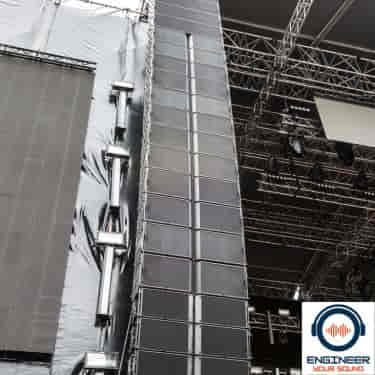
What Is A Line Array?
A line array is a loudspeaker system made up of identically shaped elements arranged in a vertical configuration.
The essential characteristic of a line array system is that it is designed to control the direction of sound, which is done by manipulating the size, shape, and angle of the array.
The following image shows a typical line array. The height (i.e. number of speakers), shape and angle of the array and individual speakers can be manipulated to ensure an even sound spread across the auditorium so those at the back or sides of the concert hall still get good sound levels and quality sound.
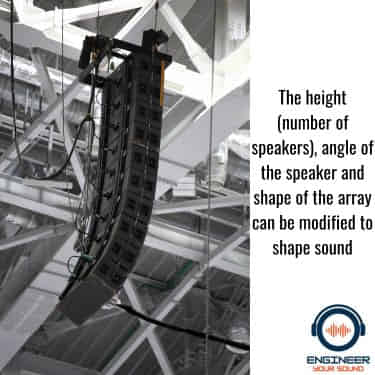
Modifying the array’s size, shape, and angle makes it possible to direct the sound where it is needed to the audience and away from areas where it can cause unwanted reflections or echoes.
The whole point of a line array is to ensure that everyone in the audience, whether in the front row or at the back of the venue, hears the same quality of sound. It’s all about creating a uniformly distributed sound field.

Why Are Line Arrays Used?
Line arrays are primarily used because they can deliver sound evenly across a large area, ensuring that all members of an audience, regardless of their location, experience high-quality sound.
These speaker systems are designed to work in concert, with each speaker unit adding to the overall sound rather than competing. This causes the sound to horizontally spread while staying consistent vertically in a cylindrical wave pattern.
For example, when we talk about a single speaker and how it disperses sound, we refer to it as a “point source”, and the sound waves will travel from it in a spherical pattern. In other words, we assume sound leaves the speaker in an omnidirectional fashion.
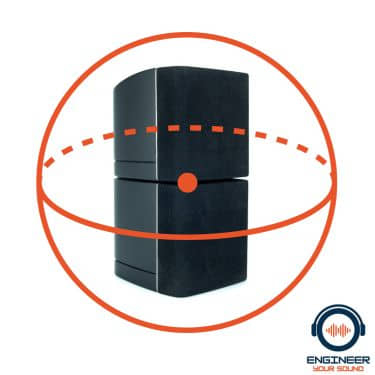
From this, we can see that as the distance from the point source (our speaker) increases, the speaker needs to project sound onto a more extensive area, and the SPL decreases.
In fact, this principle is called the inverse square law, and it tells us that the SPL drops by 6dB every time the distance doubles from a point source. (Our speaker)
However, with a line array, the sound source (our speakers) is considered to project sound as a line source, as all the speakers are in a line.
Because of this different setup, sound projection does not follow the point source law, but instead, a cylindrical wave is created.

In this instance, the wave emits from our speakers in a cylindrical fashion (a cylindrical wave).
Unlike the point source, where the level falls off by 6dB every time the distance doubles, in this instance, the SPL level only drops per 3dB every time the distance doubles.
In conclusion, line source speaker arrays produce more sound and SPL in the space or venue.
Another key advantage of line arrays is their ability to direct sound efficiently. The distinctive vertical orientation of a line array allows sound engineers to accurately steer the audio output, focusing it towards the audience and away from reflective surfaces. This minimises reverberation and echo, enhancing sound clarity and diminishing unwanted noise.
(I explain in further depth how sound engineers “steer” the audio output in greater depth later in this article. It is fascinating!)
One of the most compelling reasons for using line arrays is their scalability. They can be easily tailored to suit venues of various sizes by simply adding or removing speaker units. This versatility makes them ideal for various events, from large-scale concerts to smaller indoor gatherings.
From my experience, the control and consistency provided by line arrays are unmatched, making them necessary for any serious large venue live sound application.
How Do Line Arrays Work?
The working principle of line arrays hinges on a phenomenon known as constructive interference. This principle is derived from wave theory, where multiple waves superimpose to result in a wave of greater or lesser amplitude.
Each loudspeaker generates a sound wave in the context of a line array. When these waves overlap, they combine to create a stronger wave, resulting in a louder and clearer sound. This makes line arrays exceptionally effective in delivering sound across large audiences dispersed over a significant area.
The vertical arrangement of speakers in a line array ensures that the sound waves produced by each speaker unit are in phase. This means that the crests and troughs of the waves coincide, creating an amplified wavefront that can travel greater distances without dissipating.
Another aspect of how line arrays work is the control of dispersion. The vertical form of a line array allows for narrow vertical dispersion and broad horizontal dispersion of sound. This helps to avoid the soundwaves bouncing off the floor and ceiling, reducing echo and ensuring a clearer sound for the audience.
Adjustments can be made to the angle between the speaker units to “steer” the sound in a particular direction. This allows the sound to be focused more effectively on the audience and away from reflective surfaces, enhancing the overall audio experience.
From a personal standpoint, the way line arrays use physics principles to deliver a superior audio experience is truly fascinating and one of the reasons I find them so intriguing.
How Are Line Arrays Configured? (aka Programmed)
Configuring a line array, or as some prefer to say, programming, is a profound science that requires both technical knowledge and experience. The process begins with understanding the venue’s size, shape, and the expected audience size. This information is crucial to determining the number of loudspeaker units required and their placement in the line array system.
Once the setup is physically installed, the next stage involves a bit of mathematics and physics.
Each speaker in the array must be carefully calibrated for timing, level (volume), and equalisation (EQ) to ensure all speakers work coherently to produce a unified sound wave. This step is crucial as it dictates how well the system will perform in terms of sound quality and coverage.
Modern line arrays often have built-in digital signal processors (DSP) that assist with this calibration. DSP technology allows for precise control over each speaker element, enabling the system to optimise coverage and minimise destructive interference (where sound waves cancel each other out).
The relative level and time delay applied to each speaker unit are adjusted to’ steer’ the sound. By adjusting these parameters, sound engineers can control the vertical dispersion of the sound, directing it towards the audience and away from reflective surfaces.
The following image is from d&b ArrayCalc software. This image is a screenshot of the line array software used by live sound engineers to direct the line array’s sound to where they want it in the concert hall.
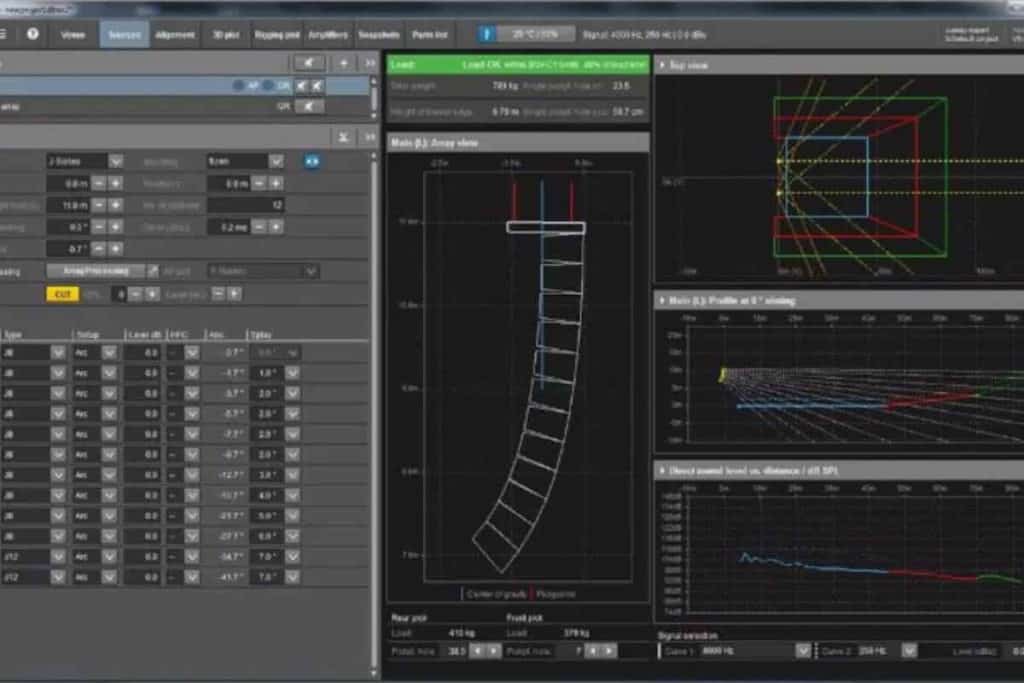
Generally, live sound engineers will try to get equal sound dispersion across the entire audience, avoiding projecting too much sound to the ceiling.
Although aiming to have the same sound level across the entire venue is admirable, this is not the best approach.
When we go to a gig, we expect it to be louder at the front; therefore, no one at a gig will complain if they perceive the sound as louder at the front and lower at the back. They may even have chosen back seats to be away from the speakers.
It is better to get good quality sound and ensure the entire audience has a happy compromise so the sound is good in their area. Do not over-saturate one area with sound.
In my experience, configuring a line array is a delicate balancing act that demands a deep understanding of acoustics and the specific characteristics of the venue.
It’s always a rewarding experience to see (and hear) the result of your careful planning and adjustments, using principles of physics and sound to create a superior audio experience for the audience.
What Is The ‘J’ Array?
The ‘J’ Array, also known as the J-hang, is a specific configuration of a line array speaker system named for its distinctive ‘J’ shape. This setup involves hanging the speakers in a vertical line but with a curve that forms the shape of the letter ‘J’.
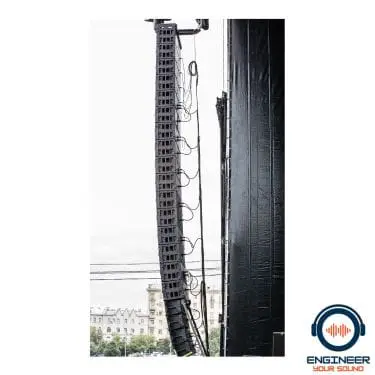
The purpose of this configuration is to provide even sound coverage to audiences located at varying distances from the stage. The’ J’ upper section aims to project the sound to the farthest sections of the audience. In contrast, the lower section directs sound to the audience members closer to the stage, ensuring a balanced and immersive audio experience for everyone.
In my experience, setting up a ‘J’ Array can be technically challenging due to the specific angling and positioning required, but the result is often worth the effort.
Modern systems will have software to help you do this, such as the D&B Audiotechnik ArrayCalc software.
What Are The Pros And Cons Of Line Array Speakers?
Line Array Advantages
Line array speakers have several advantages that make them popular for big venues and events.
- Superb Sound Quality: The principle of constructive interference used in line array speakers results in a louder and clearer sound, even over long distances.
- Versatility and Scalability: Whether you’re hosting a large-scale concert or a small indoor event, line arrays can be easily scaled up or down by adding or removing speaker units to suit the venue’s size.
- Controlled Dispersion: The vertical arrangement of speakers in a line array allows the sound to be directed more effectively towards the audience, reducing echo and enhancing overall sound quality.
- Greater Coverage: The ‘J’ Array configuration is especially helpful in ensuring a balanced audio experience for an audience spread over a large area, providing greater coverage.
Line Array Disadvantages
However, there are also some challenges or drawbacks to using line array speakers.
- Complex Setup: The setup and programming of a line array system require technical knowledge and experience. Incorrect configuration can lead to poor sound quality.
- Cost: Line arrays are expensive, especially high-quality systems. The cost might deter smaller events or venues with limited budgets.
- Heavy and Bulky: Line array systems are often large and heavy, making them less suitable for venues with limited space or weight-bearing capacity.
In my experience, the pros of line array speakers outweigh the cons, especially for large venues and events.
The superior sound quality, versatility, and control over sound dispersion that line arrays offer make them a worthwhile investment. But, as with all audio equipment, it’s important to understand your specific requirements and constraints before deciding.
Why Are Line Arrays So Expensive?
Line array speaker systems carry a higher price tag due to several factors.
Firstly, the complexity and sophistication of the technology involved contribute significantly to the cost. Each individual speaker unit within the array is equipped with a speaker and its own amplifier and processing unit.
Secondly, the materials used in building these speakers are of a higher quality to ensure durability and optimal sound production, further adding to the expense.
Furthermore, the research and development of these advanced systems are costly. Manufacturers are constantly pushing the boundaries of audio technology to deliver better sound quality, coverage, and control. This ongoing innovation comes at a price, which is reflected in the cost of the systems.
Lastly, the expense stems from the specialised knowledge needed to correctly configure and operate these systems. Installing a line array system is a complex task that often requires the expertise of trained audio engineers. Their professional skills and experience are factored into the cost of using line array speakers.
In my experience, despite the upfront cost, the investment in a line array system can be cost-effective in the long run. Their superior performance, adaptability, and longevity often justify the initial expense, especially in larger venues and events where sound quality is paramount.
Can I Use A Line Array For A Smaller Venue?
You can utilise line arrays in smaller venues, but basic PA sound systems often work in smaller venues.
What’s wonderful about line arrays is their adaptability. They can be scaled to match the venue’s requirements by adjusting the number of speaker units in the array. For smaller venues, fewer units would be used. In contrast, more units would be added for larger venues or outdoor events to achieve the required coverage and sound quality.
However, it’s also important to consider the event’s nature and the venue’s acoustics. While line arrays can deliver superior sound quality for large venues, the complexities of their setup might not be necessary in a smaller, more intimate setting. In such cases, more straightforward PA systems could serve the purpose adequately.
In my experience, every audio setup is a unique challenge that requires careful consideration of multiple factors. The key is to understand your venue and event’s specific needs and choose the equipment that best meets these requirements.
Final Thoughts
Line array speakers are a remarkable audio technology, providing unmatched sound quality and coverage. Their scalability makes them a viable option for large-scale concerts.
While they can be challenging to set up and carry a higher price tag, their exceptional performance and adaptability often justify the investment. Large venues with big audiences need them.
However, as in all areas of sound engineering, there is no one-size-fits-all solution. Understanding and considering the specific needs of your venue and event is crucial before deciding on the audio equipment.
In my experience, the careful selection and correct configuration of your audio system can dramatically enhance the overall experience of an event, making it truly memorable for the audience.
At the end of the day, audiences do not easily forgive poor audio quality. For any live event, investment in good audio will always pay off.
